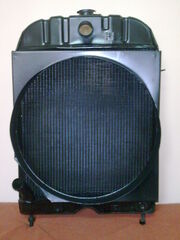Radiators and convector's are types of heat exchangers designed to transfer thermal energy from one medium to another for the purpose of cooling and heating. The majority of radiators are constructed to function in vehicles, buildings, and electronics.
One might expect the term "radiator" to apply to devices which transfer heat primarily by thermal radiation, while a device which relied primarily on natural or forced convection would be called a "convector". In practice, the term "radiator" refers to any of a number of devices in which a liquid circulates through exposed pipes (often with fins or other means of increasing surface area), notwithstanding that such devices tend to transfer heat mainly by convection and might logically be called convectors. The term "convector" refers to a class of devices in which the source of heat is not directly exposed.
Vehicles[]

A typical vehicle radiator from rear showing cowl within which the fan sits
In vehicles or machinery with a liquid-cooled internal combustion engine a radiator is connected to channels running through the engine and cylinder head, through which a liquid (coolant) is pumped. This liquid is typically a half-and-half mixture of water and ethylene glycol or propylene glycol (with a small amount of corrosion inhibitor) known as antifreeze.
The radiator transfers the heat from the fluid inside to the air outside, thereby cooling the engine. Radiators are generally mounted in a position where they will receive airflow from the forward movement of the vehicle, such as behind the grill. Where engines are rear- or mid-mounted, it's usually necessary to still mount the radiator behind the front grill, so as to achieve sufficient airflow, even though this requires long coolant pipes.
Radiator construction[]
Vehicle radiators are constructed of a pair of header tanks, linked by a honeycomb core. This core is usually made of stacked layers of metal sheet, pressed to form channels and soldered or brazed together. For many years radiators were made from brass or copper cores soldered to brass headers. Modern radiators save money and weight by using plastic headers and may use aluminium cores. This construction is less easily repaired that traditional materials. Vintage cars may also have used radiator cores made from coiled tube, a less-efficient but simpler construction.
Heater[]
The core of a heater unit is the same but smaller.
See also[]
| |||||||||||||||||||||||||||||||||||